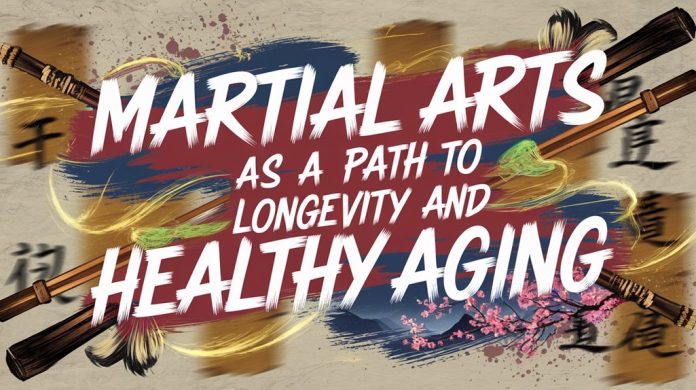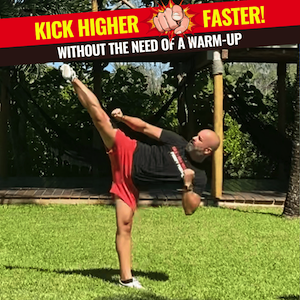Martial arts practice offers you a thorough path to healthy aging by integrating ancient wisdom with modern science. You'll build physical resilience through mindful movement patterns while enhancing cognitive function through complex techniques and strategic thinking. Regular training improves joint health, balance, and flexibility while fostering mental clarity and emotional resilience. The combination of controlled breathing, dynamic tension, and community engagement creates a sustainable approach to longevity that you'll discover goes far beyond simple exercise.
Key Points
- Regular martial arts practice combines physical exercise, mental engagement, and mindfulness techniques to promote comprehensive health and longevity.
- Traditional movements enhance joint flexibility, muscle strength, and balance control while reducing age-related physical decline.
- Consistent, moderate-intensity training builds sustainable fitness and cognitive resilience more effectively than sporadic high-intensity workouts.
- Martial arts communities provide social support and mentorship, combating isolation and maintaining mental well-being throughout the aging process.
- Mind-body practices like controlled breathing and meditation techniques reduce stress and enhance overall vitality during aging.
Ancient Wisdom Meets Modern Science
While Eastern martial arts have been practiced for millennia as paths to health and longevity, modern scientific research now validates many of their core principles.
You'll find that ancient techniques like controlled breathing, mindful movement, and dynamic tension align perfectly with current understanding of physiology and neuroscience.
These time-tested practices have modern applications that extend far beyond self-defense.
When you practice martial arts regularly, you're engaging in what scientists now recognize as multi-modal exercise – combining cardiovascular conditioning, strength training, and neuroplasticity enhancement all at once.
The emphasis on proper posture and body mechanics helps prevent age-related deterioration, while meditation aspects reduce chronic stress and inflammation.
You're not just learning combat skills – you're tapping into an integrated system of physical and mental training that bridges ancient wisdom with contemporary health science.
This synthesis offers a thorough approach to aging well and living longer. Additionally, incorporating flexibility training into your martial arts regimen is essential for maintaining optimal performance as you age.
The Martial Artist's Approach to Aging Gracefully
As you progress in martial arts training, you'll discover that harmonizing your mental and physical development creates sustainable long-term growth.
You'll find the most significant benefits come from showing up consistently for practice rather than pushing yourself to exhaustion in sporadic intense sessions.
Your dedication to regular, mindful training will help you maintain both cognitive sharpness and physical capability as you age. Additionally, incorporating flexibility and mobility training into your routine can greatly enhance your overall performance and reduce injury risk.
Training Mind With Body
Since ancient times, martial artists have recognized that physical training and mental discipline are inseparable components of healthy aging. You'll discover that mindful eating naturally emerges from martial arts practice, as you become more attuned to your body's true needs and signals.
This heightened awareness extends beyond the dojo, transforming how you approach daily activities and challenges.
Your brain's cognitive flexibility improves as you learn complex movement patterns and adapt to dynamic training scenarios.
You'll develop sharper focus, quicker reaction times, and better emotional regulation through consistent practice.
The mind-body connection strengthens when you integrate breathing techniques with movement, creating a moving meditation that reduces stress and enhances mental clarity.
This holistic approach to training guarantees that as your physical skills advance, your mental capabilities expand in parallel.
Consistency Over Intensity
The path to lifelong martial arts mastery lies in sustainable, consistent practice rather than high-intensity bursts of training. You'll find greater rewards in showing up regularly for moderate sessions than pushing yourself to exhaustion sporadically. This mindful consistency allows your body to adapt gradually while reducing injury risk.
Think of your practice as a marathon, not a sprint. Set realistic training schedules you can maintain for decades, not just weeks or months. Your gradual progress will compound over time, building deep physical intelligence and refined technique.
Focus on quality movements and proper form rather than rushing through exercises. By training at 70-80% of your maximum effort most days, you'll develop lasting strength and skills while preserving your joints and energy for the long journey ahead.
Building Lifelong Physical Resilience
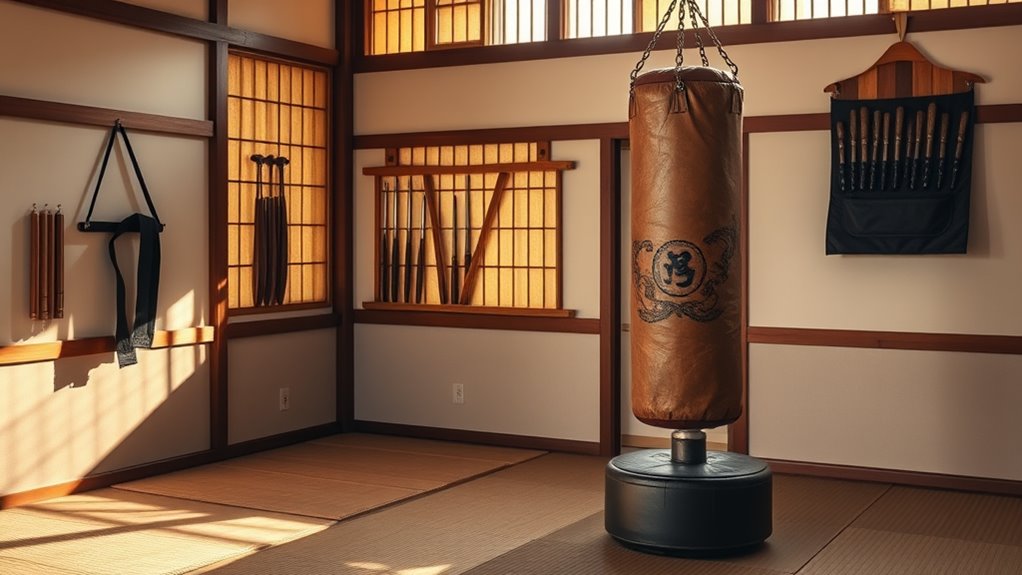
When practiced consistently, martial arts training develops physical qualities that enhance resilience throughout your lifetime. The combination of functional fitness and holistic conditioning creates a robust foundation for healthy aging. You'll develop strength, mobility, and endurance through systematic adaptation techniques.
| Training Focus | Physical Benefits | Aging Impact |
|---|---|---|
| Mobility Exercises | Joint Health | Fall Prevention |
| Strength Training | Muscle Mass | Bone Density |
| Agility Drills | Balance Control | Injury Avoidance |
| Power Development | Fast-twitch Fibers | Neural Function |
| Endurance Building | Cardiovascular Health | Energy Levels |
Through therapeutic practices and resilience training, you're not just learning self-defense – you're investing in your body's long-term functionality. Each session builds upon your physical adaptations, creating a cumulative effect that supports health as you age. This systematic approach to training guarantees you maintain functional strength and mobility while developing the physical resilience needed for lifelong independence. Additionally, regular physical activity is vital for combating age-related performance barriers.
Mental Sharpness Through Movement
Physical resilience pairs naturally with cognitive enhancement in martial arts training.
You'll discover that martial arts challenge your brain through complex movement patterns and strategic thinking. Each technique you learn acts as mental acuity exercises, forcing your mind to process spatial relationships, timing, and body mechanics simultaneously.
The cognitive movement benefits extend beyond the training floor. As you practice forms and sequences, you're building new neural pathways that enhance memory, focus, and decision-making abilities.
Research shows that combining physical movements with mental engagement creates stronger cognitive reserves, which can help protect against age-related mental decline.
You'll find that martial arts training demands complete mental presence. Whether you're learning a new kata or sparring with a partner, your brain must constantly adapt, analyze, and respond.
This dynamic mental workout strengthens your cognitive flexibility and problem-solving skills, contributing to sharper mental performance in daily life. Additionally, mental preparation is crucial for achieving competitive success, enhancing both your physical and cognitive abilities.
Balancing Mind and Body After 50
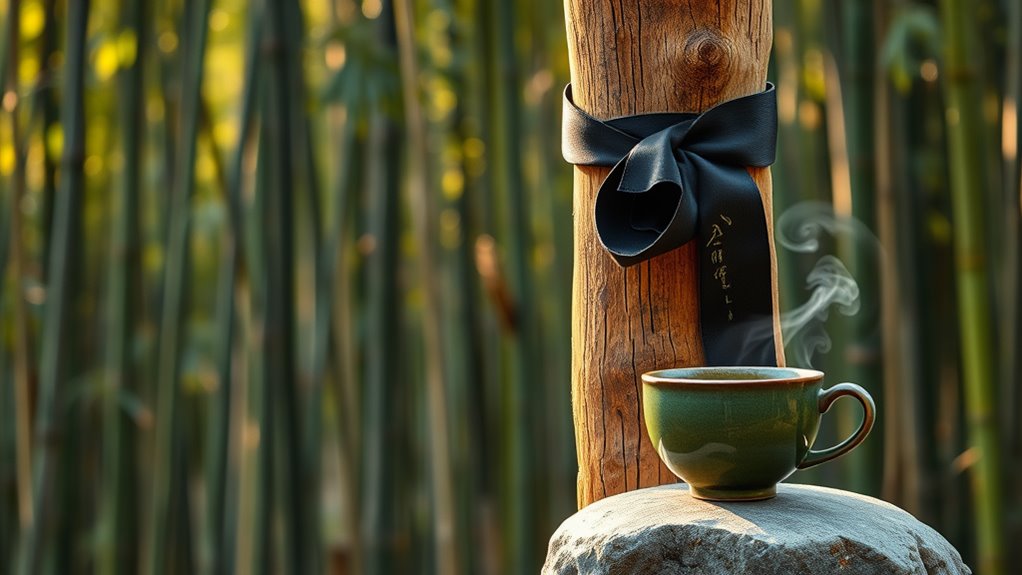
As you enter your fifties and beyond, you'll discover maintaining balance between physical and mental wellness requires mindful movement routines that prioritize joint health and proper recovery time.
Your daily martial arts practice needs to focus on controlled, purposeful movements that strengthen your core while reducing impact stress on joints and ligaments. Incorporating injury prevention techniques such as proper warm-ups and gradual progression can further enhance your training experience.
Through consistent training, you'll build mental resilience alongside physical strength, creating a sustainable foundation for long-term health and vibrancy.
Mindful Movement Every Day
Since turning 50 brings natural changes to balance and coordination, mindful movement becomes essential for maintaining energy and preventing falls. You can enhance your daily flow through simple martial arts exercises that strengthen both mind and body.
Start with gentle tai chi movements or basic karate stances to build awareness of your breath and positioning.
Make conscious practice a cornerstone of your routine by incorporating martial arts movements into everyday activities. When reaching for objects, practice proper stance alignment. While walking, focus on each step's placement and weight distribution.
These mindful moments build neural pathways that improve your reflexes and spatial awareness. Soon you'll notice increased stability, sharper focus, and a deeper mind-body connection that serves you throughout your day.
Recovery and Joint Health
Through consistent martial arts training, your body needs proper recovery time to maintain joint health and prevent overuse injuries.
You'll want to incorporate joint lubrication techniques like gentle circular movements and controlled stretches before and after training sessions. These movements help distribute synovial fluid throughout your joints, reducing friction and wear.
When injuries occur, focus on proven injury recovery strategies that don't compromise your long-term practice. Apply the RICE method (Rest, Ice, Compression, Elevation) for acute issues, but don't stay idle too long.
Movement promotes healing, so incorporate low-impact exercises that maintain mobility without aggravating the injury. Listen to your body's signals and adjust your training intensity accordingly.
Regular bodywork like massage and acupuncture can support your joint maintenance routine and accelerate recovery.
Building Core Mental Strength
Mental resilience becomes increasingly essential for martial arts practitioners over 50, requiring deliberate development alongside physical training.
You'll find that incorporating mindfulness techniques into your practice strengthens your ability to maintain focus during complex movements and combat scenarios. Through consistent meditation and breath work, you're building emotional resilience that extends beyond the dojo.
Your mental fortitude develops through challenging yourself in controlled environments, where you learn to manage stress and anxiety effectively. By practicing visualization techniques before executing moves, you're creating stronger neural pathways that enhance performance.
The discipline you cultivate through martial arts training rewires your brain for better emotional regulation and decision-making under pressure. This mental conditioning becomes a powerful tool for maneuvering life's challenges while maintaining physical and psychological balance.
Traditional Training Methods for Senior Health
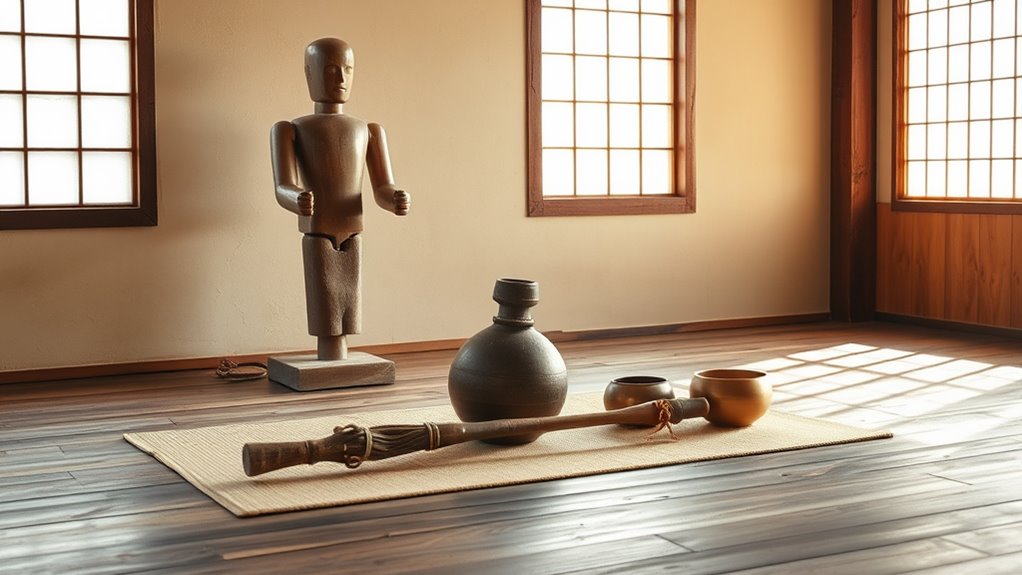
While modern exercise programs often overlook time-tested wisdom, traditional martial arts training methods offer valuable approaches for maintaining health in your senior years.
You'll discover that gentle, flowing movements like those found in Tai Chi and Qigong help in nurturing resilience while reducing the risk of falls and injury.
These ancient practices emphasize proper breathing, balanced posture, and mindful movement – all essential elements for aging bodies. You'll learn to coordinate your breath with each technique, fostering companionship between body and mind.
Mindful movement and proper breathing create harmony between body and spirit, building a foundation for graceful aging.
Traditional methods also incorporate progressive resistance training using body weight, which helps maintain bone density and muscle mass without straining your joints.
You can adapt these time-honored practices to your current fitness level and gradually build strength, flexibility, and balance.
The systematic approach of traditional training guarantees you're developing sustainable habits that support long-term health and independence.
Adapting Martial Arts for Aging Bodies
As your body changes with age, adapting traditional martial arts techniques becomes essential for maintaining safe and effective practice.
You'll need to adjust your movements to protect joints and prevent injury while still developing strength and skill. Focus on incorporating adaptive techniques that work with your current mobility level rather than forcing your body into potentially harmful positions.
Start by modifying high kicks to mid-level or low kicks, and implement flexibility adaptations that respect your range of motion.
Replace explosive movements with controlled, flowing sequences that maintain effectiveness while reducing impact. You can transform joint-intensive throws into gentler redirections and strategic weight shifts.
Consider incorporating more standing meditation and breathing exercises to enhance your internal energy development.
Remember that adaptation isn't about limitation – it's about evolution.
These modifications allow you to continue your martial journey while honoring your body's changing needs and capabilities.
The Science Behind Martial Arts Longevity

Recent scientific studies have revealed the physiological mechanisms behind martial arts' remarkable effects on longevity.
When you practice martial arts consistently, you're activating multiple biological pathways that support healthy aging. Research shows that these ancient practices trigger cellular responses that can slow down age-related decline.
Your body responds to martial arts training in powerful ways that promote longevity:
- The mindful movements enhance neuroplasticity, creating new neural pathways that keep your brain young and adaptable.
- Regular practice optimizes hormone production, particularly growth hormone and testosterone, which help maintain muscle mass and bone density as you age.
- The combination of physical exertion and meditative focus reduces chronic inflammation, a key factor in age-related diseases.
These scientific findings explain why martial artists often maintain their vibrancy well into their later years.
You're not just learning self-defense; you're engaging in a practice that fundamentally transforms your body's aging process at the cellular level.
Stress Management Through Combat Arts
Modern combat arts offer powerful tools for managing daily stress through their unique blend of physical exertion and mental discipline.
While practicing self defense skills, you'll discover how breathing exercises and mindfulness techniques naturally integrate into your movements, creating a powerful foundation for emotional balance. The physical challenge of training helps release tension while building mental resilience.
Combat training unites breath, mindfulness and movement to build emotional stability while physical challenges forge mental strength.
You'll find that combat arts provide a structured approach to stress relief that goes beyond traditional exercise. As you develop heightened awareness through practice, you'll notice improved focus in your daily life.
The discipline teaches effective conflict resolution strategies that you can apply both on and off the training floor. Through consistent training, you'll experience personal empowerment that transforms how you handle pressure situations.
Combat arts create a thorough system for managing stress – combining movement, breath control, and mental conditioning to help you navigate life's challenges with greater composure and confidence.
Breathing Techniques for Vitality

Traditional martial arts breathing techniques serve as powerful tools for enhancing your overall energy and longevity. Through systematic breath control techniques, you'll discover how to tap into your body's natural energy systems while improving your physical and mental performance.
When you practice diaphragmatic breathing in martial arts, you're engaging in methods that ancient warriors used to maintain composure and build internal power. These time-tested practices can transform your daily life and combat the effects of aging.
- Deep, controlled breathing activates your parasympathetic nervous system, reducing stress and inflammation.
- Regular practice strengthens your diaphragm, improving oxygen efficiency and cardiovascular health.
- Proper breath control during movement enhances your balance, coordination, and mental clarity.
You'll find that integrating these breathing practices into your martial arts training creates a foundation for sustained energy. By mastering your breath, you're revealing an essential key to longevity that transcends mere physical exercise.
Joint Health and Martial Movement
You'll find that martial arts training naturally promotes joint flexibility through deliberate movements that work your body through its full range of motion.
When you practice proper form and technique, you're creating protective strength around your joints while learning to move in ways that prevent injury.
Building stability through controlled, methodical movements allows your joints to become more resilient as you age, which is especially important for maintaining mobility and independence.
Promoting Joint Flexibility
Regular practice of martial arts movements can greatly enhance joint flexibility and mobility across all age groups. Through mindful training, you'll develop better range of motion and improved joint health that supports lifelong wellness. Flexibility exercises incorporated into martial arts training help prevent stiffness and maintain smooth, fluid movement patterns.
- Dynamic stretching routines prepare your joints for training while increasing mobility
- Progressive joint mobility drills strengthen supporting muscles and connective tissue
- Traditional stances and forms naturally encourage full ranges of motion
When you practice martial arts consistently, you're investing in joint health that pays dividends as you age. The combination of controlled movements, proper alignment, and gradual progression allows you to build flexibility safely while honoring your body's natural limitations.
This sustainable approach helps maintain joint function throughout life.
Injury Prevention Through Form
Building on the benefits of joint flexibility, proper martial arts form serves as your primary defense against training injuries. When you practice precision techniques with injury awareness, you're creating protective patterns that safeguard your body during intense training.
Focus on mindful execution of each movement, maintaining proper alignment even during challenging sequences. Protective postures become second nature through stability drills, but you'll need to stay vigilant about form retention, especially when fatigue sets in.
If you do experience setbacks, proper form is vital for injury recovery – it prevents compensation patterns that could lead to further problems. Master the fundamentals before advancing to complex movements, and you'll develop a sustainable practice that supports your martial arts journey while minimizing the risk of training-related injuries.
Gentle Movement Builds Stability
While aggressive training might seem essential for martial arts progress, gentle movement practices form the foundation of joint stability and longevity. Through gentle shifts and mindful pacing, you'll develop deeper body awareness and protect your joints for lifelong practice.
- Start with slow, controlled movements to build proprioception and balance
- Focus on smooth weight transfers that strengthen stabilizing muscles
- Practice fluid shifts between stances to enhance joint mobility
Your joints will thank you for taking this measured approach. By emphasizing quality over speed, you're training your nervous system to maintain stability even during dynamic movements.
This method allows you to build a resilient foundation that supports more intense training while preventing wear and tear on your joints. You'll discover that mastery comes from patience and precision rather than force.
Building Core Strength at Any Age
Core strength serves as the foundation for every martial arts movement, and it's never too late to develop this essential component of fitness. When you practice core stability training through martial arts, you're engaging not just surface muscles but deep stabilizing muscles that protect your spine and internal organs.
Core training in martial arts engages both visible and hidden muscles, creating a strong foundation for all movements and protecting vital structures.
Start with basic movements and gradually progress as your strength improves. You'll find that core strength workouts in martial arts differ from conventional ab exercises. Instead of isolated crunches, you'll perform integrated movements that challenge your entire midsection.
Through forms and stances, you'll develop functional strength that translates to better posture, balance, and overall movement quality. Begin with fundamental stances like horse stance and front stance, focusing on engaging your core throughout each position.
As you advance, incorporate twisting movements, kicks, and dynamic shifts that further challenge and strengthen your core muscles.
Fall Prevention Through Martial Training

Learning to fall safely ranks among the most valuable skills martial arts can teach aging practitioners. Through systematic training, you'll develop reflexes and techniques that can prevent serious injuries when unexpected falls occur. This essential aspect of martial arts training directly translates to everyday fall prevention, helping you maintain independence and confidence as you age.
Key benefits of martial arts fall training include:
- Development of automatic protective responses that activate during unexpected loss of balance
- Strengthening of muscles important for maintaining stability and recovering from stumbles
- Learning to distribute impact forces across your body to minimize injury risk
You'll find that regular practice of falling techniques not only builds physical resilience but also reduces fear of falling – a major factor that can limit activity in older adults.
Social Benefits of Dojo Communities
Beyond the physical benefits, training in a dojo provides valuable social connections that can combat isolation and enhance mental wellbeing as you age. Through dojo dynamics, you'll build lasting friendship bonds with training partners who share your dedication to martial development.
These community connections create robust support networks that extend beyond the training floor. The collaborative learning environment fosters collective growth as you exchange techniques and insights with peers.
You'll find mentorship opportunities flowing both ways – receiving guidance from senior students while supporting newer practitioners. The shared experiences of overcoming challenges and achieving milestones strengthen social interactions among practitioners of all ages and backgrounds.
Regular cultural exchange through martial traditions and dojo customs enriches your worldview while creating meaningful connections. You'll discover that the relationships formed through consistent training become an integral part of your social support system, contributing greatly to your overall quality of life.
Mindfulness in Motion
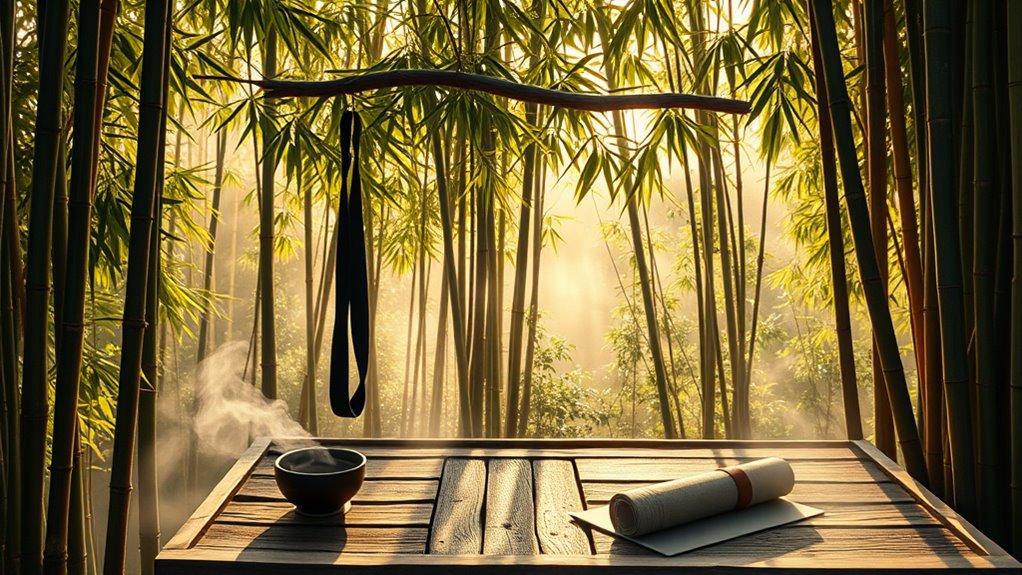
When you train in martial arts with focused awareness, you'll notice a profound mind-body connection developing through each movement and technique.
Your practice becomes a moving meditation as you sync your breath with precise actions, making every strike, block, and stance an exercise in present-moment consciousness.
Through regular training, you'll experience how this mindful motion carries over into daily life, helping you stay centered and aware even outside the dojo.
Moving With Present Awareness
Moving mindfully through martial arts practice transforms ordinary physical movements into a form of meditation. By cultivating present movement awareness during your training, you'll discover deeper dimensions of each technique while strengthening your mind-body connection.
- Each strike, block, and stance becomes an opportunity to develop mindful awareness of your breath, balance, and bodily sensations.
- Through focused practice, you'll notice subtle shifts in energy, muscle engagement, and spatial relationships.
- Your heightened present-moment consciousness carries over into daily activities, enhancing overall mind-body coordination.
When you approach martial arts with this level of attention, you're not just learning self-defense – you're developing a powerful tool for maintaining mental clarity and physical vitality as you age.
This mindful movement practice helps integrate your awareness across all aspects of training.
Mind-Body Connection Through Training
Training martial arts cultivates a deep synergy between mental focus and physical action that extends far beyond the practice mat. As you refine your techniques, you'll discover how mindful breathing patterns directly influence your movement quality and power generation.
Each strike, block, and stance becomes an opportunity to deepen your emotional awareness through embodied presence. You'll notice subtle shifts in your nervous system as you practice – increased calm during intense drills, sharper focus during complex sequences, and a natural integration of mind and body.
This heightened state of unified awareness carries over into daily activities, helping you move through life with greater coordination and emotional equilibrium. The mind-body connection you develop through consistent training becomes a powerful tool for maintaining health as you age.
Flowing Like Meditation
Have you ever noticed how fluid martial arts movements can mirror the tranquil qualities of meditation? When you engage in flowing movements during training, you're actually practicing a dynamic form of meditation practice. Your mind and body unite in a seamless dance of focused awareness.
The meditative flow state in martial arts offers unique benefits:
- Your nervous system naturally calms as you sync breath with movement
- You develop heightened presence and mindfulness that carries into daily life
- Your mental clarity improves through the rhythmic patterns of technique
As you progress in your training, you'll discover that martial arts becomes less about individual techniques and more about the continuous flow between movements.
This flowing meditation practice cultivates a deeper mind-body connection that can profoundly impact your overall wellbeing and personal growth.
Energy Cultivation Practices
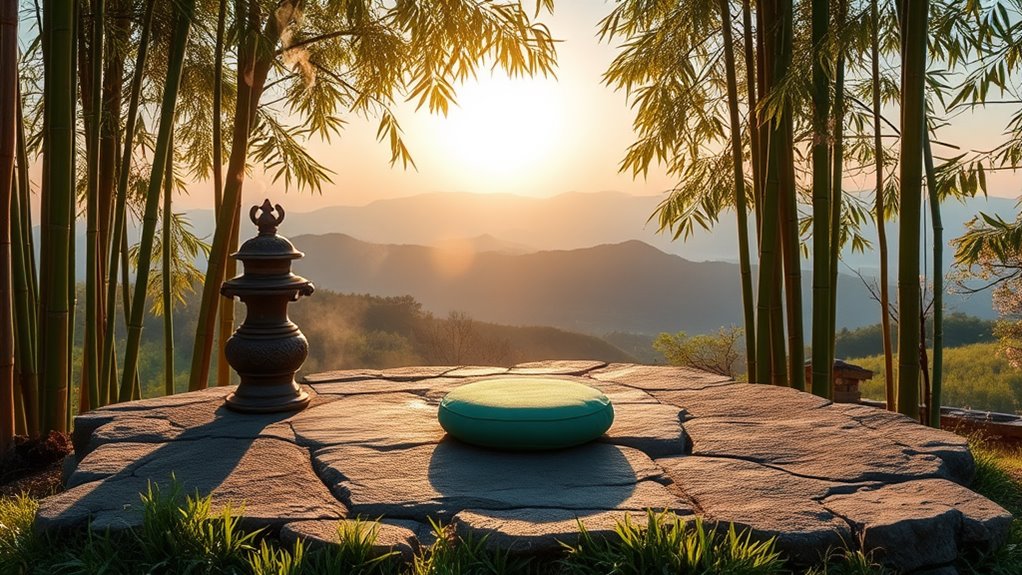
Energy cultivation stands at the heart of many traditional martial arts systems, particularly those rooted in Eastern practices like Qigong and Tai Chi. Through specific breathing techniques and focused movement patterns, you'll develop an awareness of your body's energy flow.
These ancient practices combine mindful visualization with coordinated physical actions to enhance your liveliness and promote cellular regeneration.
You'll learn to direct your breath and attention to specific energy centers, known as meridians or chakras, depending on the tradition you're following. By practicing these methods regularly, you'll stimulate your nervous system, improve circulation, and boost your immune function.
The gentle yet powerful movements help release tension while building internal strength.
As you progress, you'll discover how to store and circulate energy throughout your body, creating a sustainable practice that supports both your martial development and overall well-being. This systematic approach to energy cultivation becomes a cornerstone of your longevity practice.
Flexibility Training for Seniors
You'll want to adapt traditional martial arts stretching routines with modifications that protect aging joints while still building flexibility.
Your daily practice should focus on gentle, progressive stretching that gradually increases range of motion in key areas like hips, shoulders, and spine.
Safe Stretching Modifications Daily
While traditional martial arts training emphasizes flexibility, seniors need specific modifications to prevent injury and maintain joint health. You'll want to focus on safe stretching techniques that gradually build dynamic flexibility without overextending.
Start with gentle movements and progress slowly as your body adapts.
- Begin each session with 5-10 minutes of light walking or marching in place to warm up your muscles.
- Hold stretches for 15-30 seconds, breathing deeply and never bouncing or forcing the movement.
- Listen to your body and back off if you feel sharp pain or discomfort.
You can adapt martial arts stretches by using props like chairs for balance, reducing the range of motion, or practicing seated variations.
Regular practice helps maintain mobility while respecting your current physical capabilities.
Building Joint Mobility Range
Building joint mobility requires a methodical approach that expands on your basic stretching routine.
Start with gentle dynamic stretching to warm up your active joints before incorporating more challenging mobility drills. You'll want to focus on key movement patterns that support your martial arts practice.
Use elastic bands to assist with range improvement, especially for shoulders and hips. These tools help you maintain control while exploring new ranges of motion.
Practice joint lubrication exercises through slow, controlled rotations of each major joint. Begin with smaller movements and gradually increase your range.
Combine flexibility exercises with breathing techniques to enhance your body's natural response to stretching.
You'll find that consistent practice of these stretching techniques leads to better joint mobility and improved performance in your martial arts training.
Pain Management Through Martial Arts
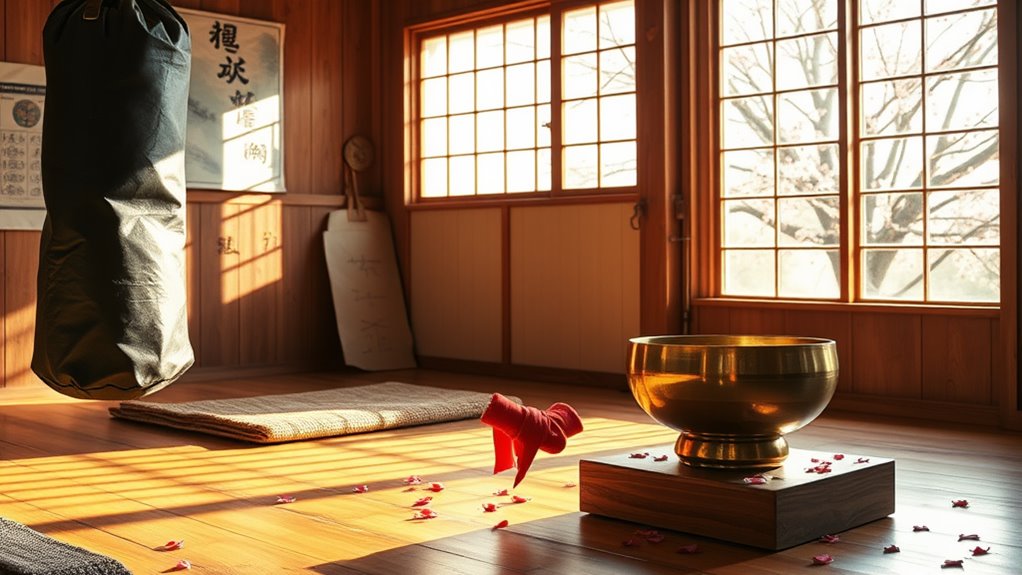
Although chronic pain affects millions worldwide, regular martial arts practice offers natural ways to manage and reduce various types of discomfort. Through martial arts therapy and holistic healing methods, you'll discover how to work with your body rather than against it.
Combat sports benefits extend beyond physical conditioning to include enhanced body awareness practices that help you better understand and respond to pain signals.
- Pain relief techniques in martial arts emphasize proper breathing, movement patterns, and gradual progression to build resilience
- Self defense training incorporates exercise modifications that respect your current limitations while slowly expanding your capabilities
- Mental health benefits emerge as you gain confidence in managing discomfort through structured injury recovery strategies
You'll find that martial arts pain management approaches offer a sustainable path to better mobility and reduced pain.
As you develop greater body awareness, you'll naturally adopt more effective movement patterns that support long-term healing and functionality.
Cognitive Benefits of Forms Practice
Your brain gets a powerful workout when you practice martial arts forms through focused memorization of movement patterns.
As you learn to execute complex sequences with precision, you'll strengthen neural pathways that support memory formation and sustained attention.
The mindful practice of forms engages multiple cognitive domains simultaneously – from spatial awareness to sequential processing – helping to keep your mind sharp as you age.
Mindful Movement Builds Focus
How does practicing martial arts forms affect your mental sharpness? Through mindful practice and movement awareness, you'll discover that martial arts training heightens your focus in profound ways.
The deliberate concentration required during forms practice trains your mind to stay present and engaged.
When you practice forms with full attention, you'll experience:
- Increased ability to quiet mental chatter and achieve flow states
- Enhanced proprioception and spatial awareness as you move through complex patterns
- Deeper mind-body connection that carries over into daily activities
Your focused movement practice becomes a moving meditation, sharpening your mental clarity while reducing stress.
This mindful approach to training helps you develop sustained concentration that benefits both your martial arts practice and cognitive performance in other areas of life.
Memory Through Pattern Mastery
Beyond sharpening mental focus, martial arts forms practice offers significant memory-building benefits.
As you learn complex movement patterns, you're engaging in natural cognitive training exercises that strengthen neural pathways. Each form becomes a physical memory enhancement technique, requiring you to recall precise sequences while maintaining proper body mechanics.
Building Bone Density Through Impact
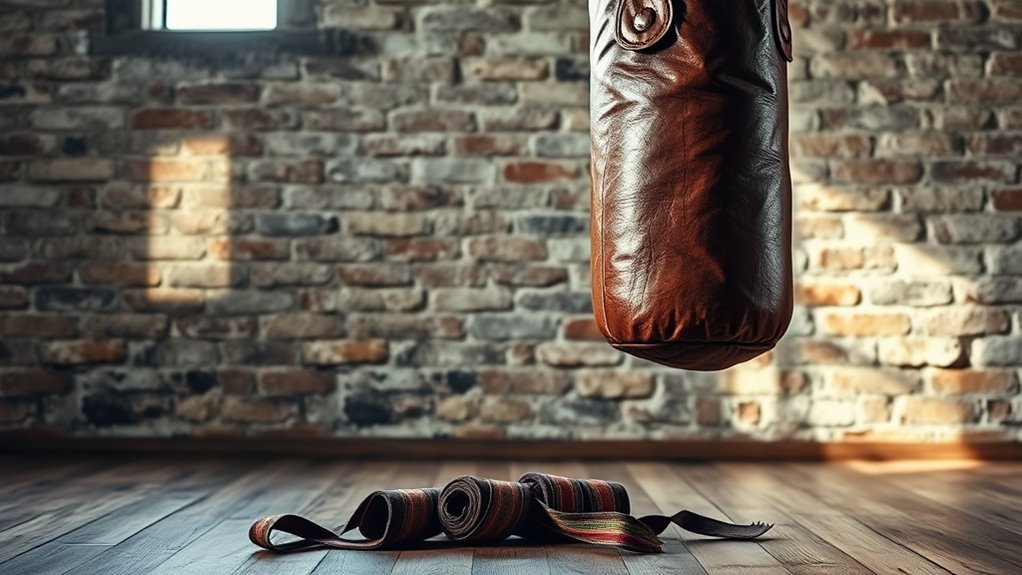
As martial artists age, bone density becomes increasingly essential for maintaining strength and preventing injury. Through regular impact exercises and density training, you'll stimulate osteoblast activity – the cells responsible for building new bone tissue.
Every strike, kick, and fall creates micro-stresses that signal your body to strengthen its skeletal structure.
Research shows martial arts training offers unique benefits for bone health:
- Varied impact angles challenge bones from multiple directions, creating thorough skeletal loading
- Partner drills and striking combinations provide progressive resistance that adapts to your skill level
- Traditional forms practice integrates weight-bearing movements with dynamic balance challenges
You'll find that consistent martial arts practice naturally incorporates the key elements needed for bone density development. The combination of controlled impacts, weight-bearing stances, and explosive movements creates an ideal environment for maintaining strong, resilient bones throughout your aging journey.
Heart Health and Martial Conditioning
Regular martial arts training delivers three key cardiovascular benefits you won't find in most other workouts.
First, you'll experience interval-based heart rate fluctuations that strengthen your heart's ability to handle stress. The dynamic nature of sparring and forms practice creates natural high-intensity intervals that boost your cardiovascular endurance.
Second, you'll develop breath control through focused techniques, helping regulate blood pressure and improve oxygen efficiency.
The third benefit comes from martial conditioning's unique blend of explosive movements and sustained effort.
As you practice strikes, blocks, and footwork, you're engaging in compound exercises that challenge your heart in ways different from standard cardio. Your heart learns to efficiently pump blood to multiple muscle groups simultaneously while adapting to quick directional changes.
This thorough approach to heart health through martial training helps build a resilient cardiovascular system that serves you well into your later years.
Balance Training for Life

You'll build essential dynamic stability as you practice martial arts movements that challenge your balance in multiple directions and planes.
The balance training you gain through martial arts directly connects to fall prevention – a significant factor in maintaining independence as you age.
Whether you're a beginner or experienced practitioner, you can enhance your equilibrium at home by practicing basic stances, slow-motion kicks, and controlled weight shifts between poses.
Dynamic Stability Through Movement
Mastering dynamic stability through martial arts training creates a foundation for lifelong balance and mobility. When you practice martial arts movements, you're developing dynamic coordination that carries over into everyday activities. Your body learns to maintain stability while moving through complex patterns, enhancing your movement efficiency.
- Your nervous system adapts to quick directional changes, improving your ability to prevent falls.
- You'll develop fluid shifts between stances, strengthening core stabilizers and leg muscles.
- Your proprioception sharpens, making you more aware of your body's position in space.
These movement skills become increasingly valuable as you age, helping you maintain independence and confidence in your physical abilities.
The dynamic nature of martial arts training continuously challenges your balance systems, creating lasting adaptations that serve you throughout life.
The Fall Prevention Connection
Through dedicated martial arts training, you'll discover one of its most valuable benefits – enhanced fall prevention abilities. Your heightened fall awareness and proactivity training will transform how you move through daily life, empowering you to navigate potential hazards with confidence.
| Skill Developed | Real-Life Impact |
|---|---|
| Break-fall techniques | Minimize injury risk |
| Balance control | Prevent common slips |
| Spatial awareness | Avoid hazardous situations |
You'll learn to instantly recognize shifts in your center of gravity and respond appropriately when unexpected situations arise. These skills become particularly important as you age, helping you maintain independence and mobility. The deliberate practice of martial arts movements trains your body to react instinctively, creating neural pathways that activate automatically when you encounter unstable situations.
Training Equilibrium at Home
While martial arts training often occurs in dojos or studios, practicing balance exercises at home can greatly reinforce and complement your formal instruction.
You'll find that dedicating just 15 minutes daily to home training can considerably improve your stability and confidence.
Here are some effective balancing exercises you can practice in your living space:
- Stand on one leg while performing everyday tasks like brushing your teeth or washing dishes
- Walk heel-to-toe across your room, focusing on a fixed point ahead
- Practice slow, controlled martial arts kicks, holding each position for 5-10 seconds
Muscle Memory and Neural Plasticity

The incredible adaptability of your brain and body forms the foundation of martial arts training. When you consistently practice techniques, you're actively rewiring neural pathways and enhancing muscle coordination through a process called neuroplasticity.
Your brain creates stronger connections each time you repeat a movement, making it more efficient and natural over time. Through mindful practice, you'll notice how techniques that once required intense concentration become second nature.
Practice transforms complex movements into instinctive responses as your brain forges stronger neural pathways through repetition.
Your body develops an intuitive understanding of proper form, timing, and balance. This adaptation isn't just physical – it's reshaping your brain's architecture. Research shows that martial artists develop enhanced spatial awareness, faster reaction times, and better overall cognitive function.
You're not just learning moves; you're building a sophisticated network of neural connections that will serve you well into your later years, helping maintain both physical and mental agility as you age.
Traditional Medicine in Martial Arts
Beyond the physical movements and neural adaptations, martial arts systems incorporate ancient healing practices that have endured for centuries.
Traditional medicine complements your martial training, offering holistic healing approaches that address both physical and energetic aspects of wellbeing.
You'll discover that many martial traditions integrate principles of energy balance through:
- Breathing techniques (qigong, pranayama) that regulate your body's essential energy
- Pressure point therapies and self-massage methods to release tension and promote healing
- Herbal remedies and dietary practices passed down through generations of practitioners
These traditional healing arts aren't just complementary – they're crucial to your martial arts journey.
By understanding and applying these time-tested methods, you're tapping into wisdom that supports recovery, prevents injury, and maintains your body's natural harmony.
This integration of combat skills and healing knowledge creates an all-encompassing system that serves both your immediate training needs and long-term health goals.
Recovery Techniques for Aging Athletes

You'll find active rest is essential for aging martial artists, involving low-intensity movements between training sessions to maintain flexibility while allowing muscle recovery.
When you're not actively training, focus on gentle joint mobility exercises that promote circulation without adding stress to your connective tissues.
You can protect your joints by incorporating targeted strengthening exercises for the supporting muscles around vulnerable areas like knees and shoulders during these recovery periods.
Active Rest Methods
Recovery becomes increasingly essential as martial artists age, requiring a balanced approach between training intensity and rest periods.
Active rest methods allow you to maintain fitness while giving your body time to heal and rebuild. Through mindful recovery practices, you'll optimize your training potential while reducing injury risk.
Consider incorporating these active rest approaches into your routine:
- Light movement exercises like tai chi or gentle forms practice to maintain mobility without strain
- Nature walks combined with breathing techniques to enhance mental recovery while staying physically engaged
- Low-intensity mobility drills that keep joints fluid while allowing muscle recovery
These methods help you stay connected to your martial practice while giving your body the regeneration time it needs.
Joint Protection Practices
While active rest helps maintain overall conditioning, protecting your joints throughout your martial arts journey demands specific attention and care. You'll need to implement joint stabilization strategies and proactive injury prevention techniques to guarantee longevity in your practice.
| Protection Method | Benefits |
|---|---|
| Dynamic Warmups | Increases synovial fluid flow |
| Proper Alignment | Reduces unnecessary stress |
| Controlled Impact | Preserves cartilage health |
| Support Exercises | Strengthens surrounding muscles |
| Recovery Protocol | Promotes tissue repair |
You'll find that these protection practices aren't just about avoiding injury – they're about building a sustainable foundation for your martial arts practice. Focus on maintaining proper form during techniques, use appropriate protective gear, and listen to your body's signals. When you integrate these strategies consistently, you're investing in your ability to train well into your later years.
Dietary Wisdom From Eastern Arts
Throughout centuries of development, Eastern martial arts have cultivated dietary practices that complement physical training and promote overall wellness.
You'll find these ancient wisdom traditions emphasize dietary balance through mindful eating and seasonal adjustments to food choices. Many martial arts systems integrate herbal remedies and specific nutritional guidelines to support energy, recovery, and longevity.
Consider these core principles from traditional martial arts nutrition:
- Emphasis on warming foods before training and cooling foods for recovery
- Integration of medicinal herbs and teas to enhance performance and healing
- Balance of proteins, whole grains, and seasonal vegetables aligned with training intensity
You'll discover that these dietary practices aren't just about fueling your workouts – they're about creating harmony between your body, mind, and training regimen.
Meditation in Movement

Despite its dynamic nature, martial arts training deeply intertwines with meditative practices, creating a unique form of moving meditation.
When you practice martial arts movements, you'll discover that each technique requires focused attention combined with meditative breathing, much like traditional seated meditation.
You'll experience flowing mindfulness as you coordinate your breath with strikes, blocks, and footwork. This synchronization helps you enter a state of heightened awareness where movement becomes effortless.
During forms practice, you'll find yourself completely present, with racing thoughts naturally settling into calm observation.
Forms practice brings your mind into the present moment, transforming scattered thoughts into clear, mindful awareness.
This moving meditation offers unique benefits you won't find in static practices. Your body learns to maintain relaxed alertness under pressure, while your mind develops razor-sharp focus that carries into daily life.
Posture Improvement Through Training
Proper posture stands as a cornerstone benefit of martial arts training, with each discipline emphasizing correct body alignment and structural integrity.
Through consistent practice, you'll discover how martial arts naturally correct postural imbalances while strengthening your core stabilizing muscles. Regular posture assessment becomes part of your training journey, helping you identify and address alignment issues.
Key benefits you'll experience through martial arts posture training:
- Enhanced spinal alignment that reduces chronic pain and prevents future injuries
- Improved balance and coordination through stance work and alignment strategies
- Increased body awareness that carries over into daily activities
You'll notice these improvements extend beyond the training floor, impacting how you sit, stand, and move throughout your day.
As you progress, you'll develop an intuitive understanding of proper body mechanics, leading to better posture without conscious effort. This natural alignment becomes your foundation for injury prevention and sustained physical health.
Preventing Age-Related Decline

Your martial arts practice can help prevent two major age-related concerns: decreased balance and loss of core strength.
You'll notice improved stability and reduced fall risk through regular training of stances, shifts, and dynamic movements that challenge your equilibrium.
Building and maintaining core strength through martial arts helps you stay mobile and independent as you age, since these muscles support basic daily activities like walking, lifting, and maintaining proper posture.
Balance and Fall Prevention
As we age, maintaining balance becomes increasingly critical for preventing falls and preserving independence. Martial arts training offers proven balance techniques and posture exercises that strengthen your core stability and spatial awareness.
Through consistent practice, you'll develop the reflexes and muscle memory needed to catch yourself before a potential fall.
Key benefits of martial arts for balance include:
- Integration of dynamic movements that challenge your equilibrium in controlled settings
- Progressive training of balance techniques from simple stances to complex movements
- Development of lower body strength and joint stability through posture exercises
You'll find that martial arts training doesn't just improve your physical balance – it enhances your mental focus and body awareness, giving you greater confidence in your daily movements and activities.
Core Strength Maintenance
Building on the foundation of balance training, core strength plays a central role in preventing age-related muscle loss and maintaining functional independence.
Through consistent martial arts practice, you'll develop core stability exercises that target your deep abdominal muscles, lower back, and pelvic floor – essential components for maintaining posture and preventing injury as you age.
Core engagement techniques in martial arts are uniquely effective because they combine dynamic movement with isometric holds.
Whether you're practicing kicks, strikes, or forms, you're constantly activating your core muscles in functional, real-world patterns. These movements strengthen your core while improving your body's ability to respond to unexpected challenges.
You'll find that stronger core muscles help you maintain independence in daily activities, from carrying groceries to playing with grandchildren.
Healing Through Martial Movement
The healing power of martial arts extends far beyond self-defense, offering therapeutic movements that can rehabilitate injuries and reduce chronic pain. Through movement therapy and restorative practices, you'll discover how traditional martial techniques adapt into modern healing practices.
Your journey toward wellness integration begins with understanding how energy management affects both physical and emotional well-being.
- Functional training methods help you overcome mobility limitations while correcting posture through deliberate movement exploration.
- Injury rehabilitation becomes more effective when combining martial arts principles with self-care strategies.
- Personal empowerment grows as you master agility exercises designed for your unique physical needs.
Your lifestyle transformation accelerates when you embrace martial arts as a healing pathway. By following carefully adapted curriculums, you'll develop a deeper connection between mind and body.
This integration creates lasting changes in how you move, think, and recover from life's physical challenges.
Adaptations for Limited Mobility
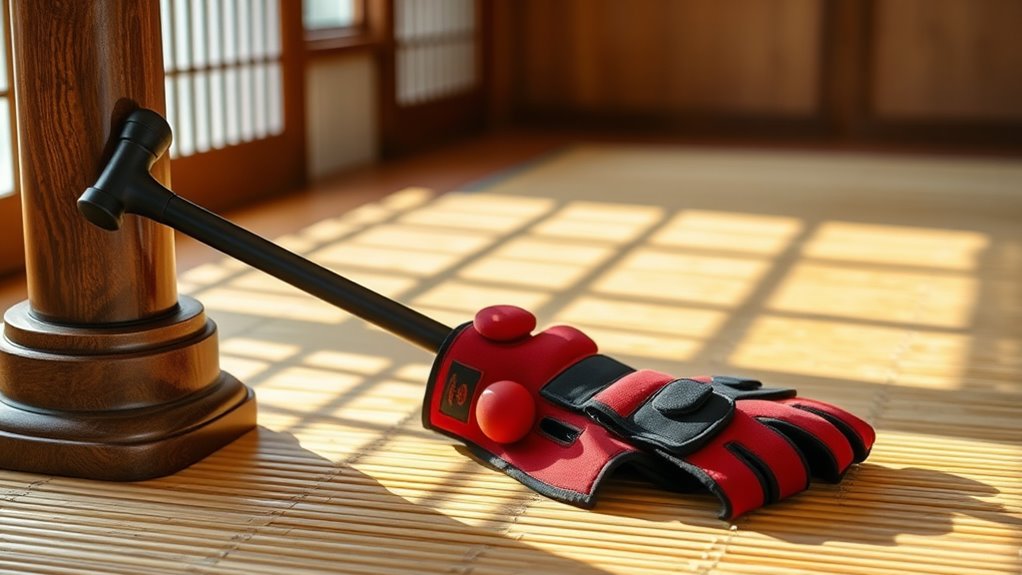
While traditional martial arts might seem intimidating for those with mobility challenges, numerous adaptations make these practices accessible to practitioners of all physical abilities. You'll find adaptive techniques that transform classical movements into exercises you can perform from various positions, including seated or supported stances.
| Position | Adaptive Technique | Benefits |
|---|---|---|
| Seated | Chair Tai Chi | Balance, Core Strength |
| Standing Supported | Wall Punches | Upper Body Power |
| Reclined | Floor Blocking | Defensive Skills |
| Assisted | Partner Forms | Coordination |
| Modified | Adapted Kicks | Leg Strength |
You can start with specific exercises that match your current mobility level and gradually progress at your own pace. Whether you're using a wheelchair, walker, or need occasional support, these modified martial movements help you build strength, improve coordination, and maintain independence. The key is finding the right adaptations that work for your unique situation while still preserving the essential principles of your chosen martial art.
Chi Development for Vitality
Through dedicated breathwork practices, you'll learn to cultivate and direct chi energy throughout your body's meridian pathways for enhanced vigor and wellbeing.
By sharpening your mental focus during martial arts training, you're able to build and concentrate energy in ways that promote physical and emotional balance.
Your consistent practice of gentle, flowing movements allows you to develop internal power while maintaining the supple strength needed for healthy aging.
Breathwork for Chi Flow
Mastering breath control techniques in martial arts releases essential energy flow, known as "chi" or "qi" in Eastern traditions.
Through consistent practice, you'll develop heightened chi awareness and experience profound energy balance throughout your body. These ancient breathing methods directly influence your energy and internal power.
Key breathwork practices to enhance your chi flow:
- Deep diaphragmatic breathing synchronized with movements to activate energy centers
- Reverse breathing techniques that compress and expand your dan tien (energy core)
- Advanced breath retention exercises to build internal pressure and power
Mental Focus Builds Energy
Mental focus serves as a cornerstone for chi development in martial arts practice. Through deliberate cognitive engagement, you'll learn to direct your internal energy with precision and purpose. This concentrated attention amplifies your body's natural energy systems while eliminating scattered thoughts that drain your energy.
You can achieve energy enhancement by maintaining unwavering focus during forms practice, meditation, and sparring exercises. Start by centering your awareness on your dan tien (lower abdomen), then expand this focused attention throughout your entire body.
As you progress, you'll notice increased stamina, sharper reflexes, and deeper mind-body connection. This mental discipline transforms routine movements into powerful energy-building exercises.
Gentle Movement Cultivates Power
Many martial artists discover that powerful results often come from the gentlest movements.
Like gentle giants in nature, your ability to generate tremendous force doesn't require aggressive motion. Instead, you'll cultivate quiet power through controlled, mindful practice.
The path to developing internal energy involves:
- Focusing on micro-movements that maximize efficiency
- Learning to relax deeply while maintaining structure
- Using breath work to enhance your natural power
Your journey into gentle movement reveals hidden strengths as you master the art of conserving and directing energy.
This approach trains your body to accomplish more with less effort – a key principle in martial arts longevity. You'll find that softness often conquers hardness, allowing you to maintain vigor while aging gracefully through your practice.
Cross-Training for Senior Health
To stay vibrant and healthy as you age, cross-training with multiple martial arts styles can greatly enhance your fitness outcomes. You'll discover that combining different disciplines maximizes your physical potential while preventing plateaus and overuse injuries. The varied movements and training approaches keep your body adaptable and your mind engaged.
| Style | Benefits |
|---|---|
| Tai Chi | Balance & Flexibility |
| Karate | Strength & Focus |
| Judo | Fall Prevention & Core |
| Wing Chun | Joint Health & Coordination |
Cross-training benefits extend beyond physical fitness flexibility – you're building a thorough movement vocabulary that serves you in daily life. Whether you're practicing soft styles like Tai Chi or more dynamic arts like Karate, each discipline contributes unique elements to your wellness journey. You'll find that alternating between different martial arts creates a sustainable, enjoyable path to maintaining strength, mobility, and mental sharpness throughout your senior years.
Partner Drills for Active Aging
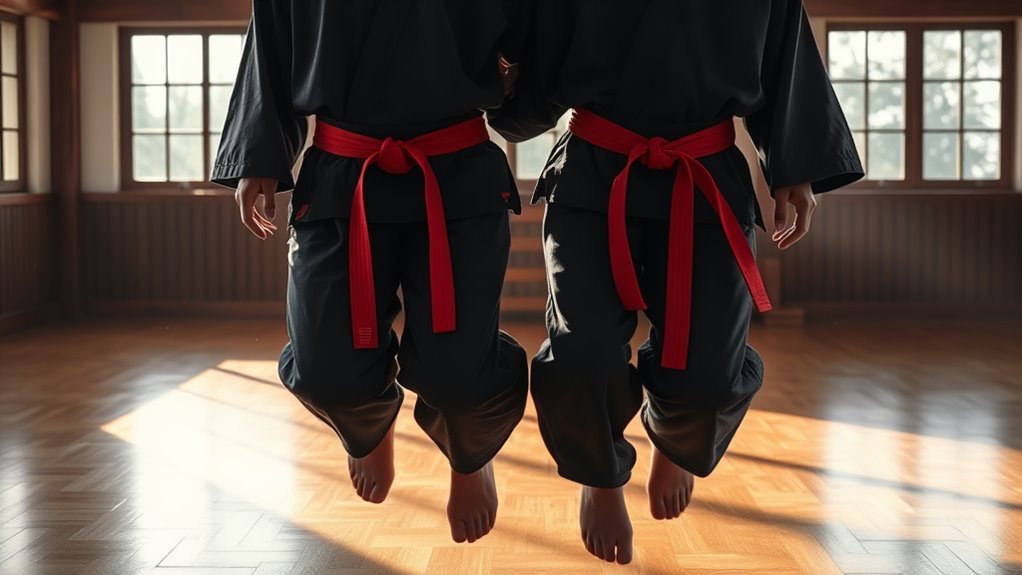
When you practice martial arts with a partner, you'll build essential physical awareness and trust while maintaining safe training boundaries that protect both participants.
These collaborative exercises improve your balance, reaction time, and ability to prevent falls through controlled movements and mutual support.
You'll learn to read your partner's energy and movement patterns, developing skills that translate directly to better mobility and stability in daily life.
Safe Training With Others
Partner training forms an essential component of martial arts practice, yet it requires special consideration as you age. When engaging in cooperative drills, you'll need to establish clear safety protocols and maintain open communication with your training partners.
Building trust through mutual support creates an environment where you can explore adaptive techniques while staying mindful of injury prevention.
- Focus on partner sparring that emphasizes control and technique rather than power and speed
- Practice clear verbal and non-verbal communication to guarantee shared understanding of intensity levels
- Develop group dynamics that support everyone's growth while respecting individual limitations
Through mindful partner work, you'll discover that shared progress often exceeds what you could achieve alone.
The key lies in balancing challenging yourself while maintaining awareness of your body's signals and your partner's needs.
Building Trust Through Practice
Building mutual trust in martial arts requires consistent practice and clear understanding between training partners. Through training consistency and practice commitment, you'll develop deeper connections that enhance your martial arts journey.
Trust building emerges naturally when you focus on respectful interactions and clear communication skills during partner drills.
As you progress in your practice, relationship fostering becomes central to your growth. You'll find that mutual support develops organically through shared experiences and challenges.
Respect cultivation happens through attentive listening and honoring your partner's boundaries. These empowerment strategies create a safe space for both partners to explore techniques and advance their skills.
Remember that trust isn't instant – it's built gradually through dedicated practice and genuine commitment to each other's development and well-being.
Balance and Fall Prevention
Safe falling techniques and balance exercises form essential components of martial arts training for active aging. When you practice these balance techniques regularly, you'll develop stronger proprioception and reduce your fall risk as you age.
Partner drills help reinforce these skills while creating a supportive learning environment.
Key benefits of martial arts balance training include:
- Learning to distribute your weight effectively during movement shifts
- Developing reflexive responses to unexpected alterations in balance
- Mastering techniques to fall safely when loss of balance occurs
Through consistent practice, you'll gain confidence in your ability to navigate daily physical challenges.
Your improved balance will transfer to everyday activities, from walking on uneven surfaces to managing household tasks. This enhanced stability becomes increasingly valuable as you continue your journey of active aging.
Strength Without Strain
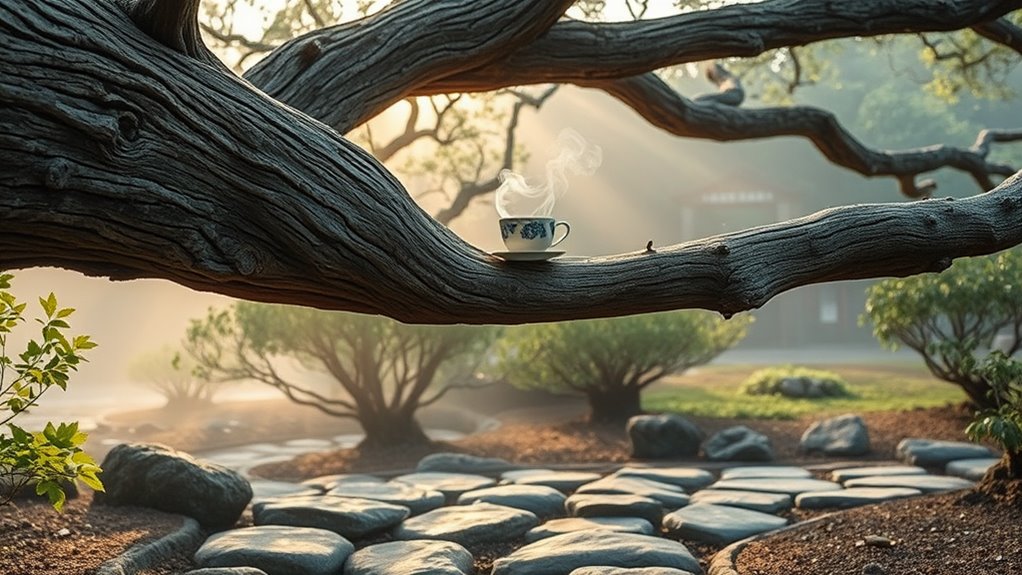
Traditional martial arts embrace an essential principle that true strength doesn't require excessive strain on your body. Through gentle workouts that focus on proper form and mindful breathing, you'll build functional strength that serves you well into your later years.
These practices teach you to move with efficiency rather than brute force.
You'll discover that by learning to harness your body's natural mechanics, you can generate remarkable power without overtaxing your joints and muscles.
This approach emphasizes smooth, controlled movements that build strength gradually while reducing the risk of injury. The key is developing what martial artists call "soft power" – the ability to generate force through relaxation and proper alignment rather than tension.
Martial Arts and Memory Enhancement
During the learning of martial arts sequences and movements, your brain creates new neural pathways that can help maintain cognitive function. The systematic nature of martial arts training serves as effective cognitive training, engaging multiple areas of your brain simultaneously.
Through consistent practice, you'll develop enhanced memory techniques that can benefit your daily life.
Here's how martial arts strengthens your memory and mental acuity:
- Complex movement patterns activate both hemispheres of your brain, improving neural connectivity and information processing
- Regular practice of forms and sequences enhances working memory and spatial awareness
- Learning defensive techniques requires quick decision-making, boosting cognitive flexibility and reaction time
You'll find that these mental benefits extend beyond the training floor. The memory-enhancing aspects of martial arts practice help protect against age-related cognitive decline while keeping your mind sharp and focused.
This cognitive training becomes particularly valuable as you age, supporting mental clarity and processing speed.
Rhythm and Coordination Training
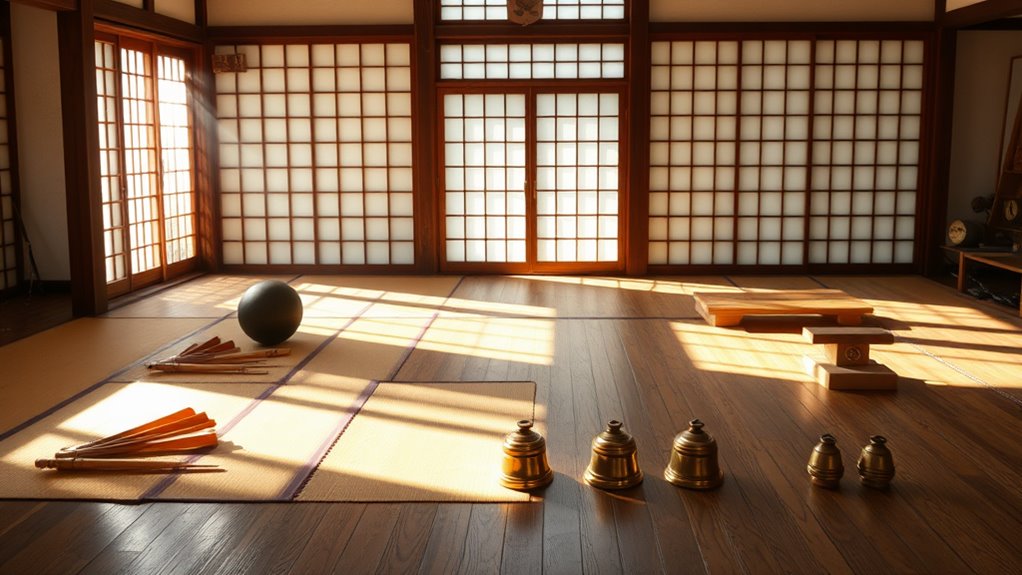
As you progress through martial arts training, you'll develop a natural sense of rhythm and timing that enhances your overall body coordination.
Through consistent practice of rhythm exercises and coordination drills, you're training your nervous system to respond with greater precision and fluidity.
You'll notice improvements in your daily movements as martial arts training integrates complex patterns that challenge your brain-body connection. The rhythmic nature of forms and combinations helps you develop timing that transfers to other aspects of life.
Simple activities like walking up stairs or catching objects become more effortless as your coordination improves.
Your body learns to move as a unified system rather than disconnected parts. This integration helps prevent falls and injuries as you age, while maintaining your independence and mobility.
The coordination skills you gain through martial arts create a foundation for lifelong physical competence and confidence in movement.
Ground Movement for Joint Health
Building on the coordination skills developed in martial arts, ground movement exercises take your joint health to the next level. Through systematic joint stabilization techniques and mobility enhancement drills, you'll discover how to move with greater freedom and resilience.
Your body's natural intelligence awakens as you explore these ancient movement patterns.
- Floor-based flowing sequences enhance your hip and shoulder mobility while protecting your spine's natural alignment.
- Animal-inspired locomotion patterns strengthen your joints through their full range of motion.
- Ground shifts challenge your body's adaptability and build protective strength around key joints.
You'll find that regular practice of these ground movements creates a foundation for lifelong joint health.
By incorporating mobility enhancement drills into your training, you're not just exercising – you're reclaiming your body's innate movement potential.
These techniques help you break free from modern movement restrictions while building lasting joint stability.
Therapeutic Applications of Forms
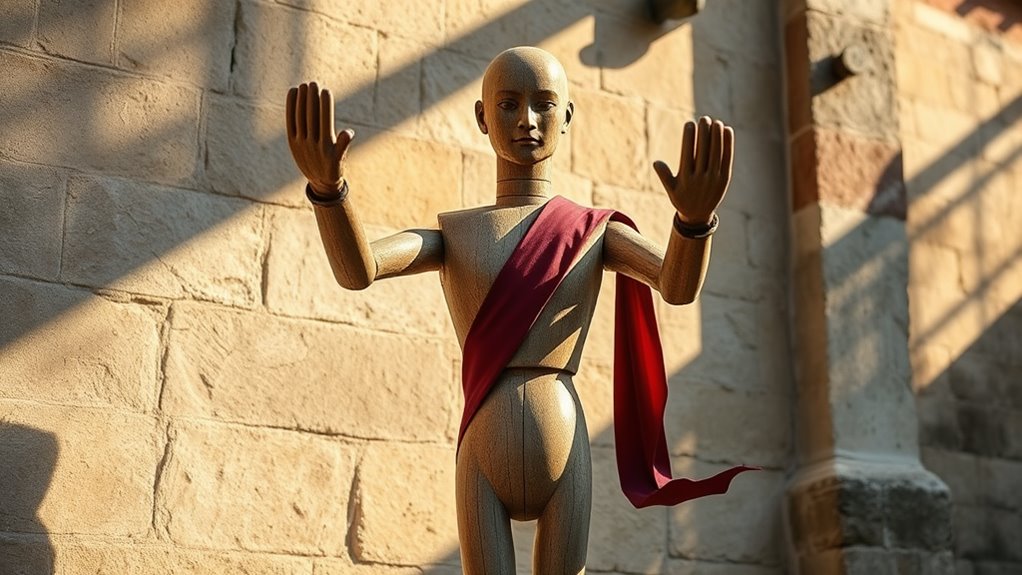
Traditional martial arts forms offer therapeutic benefits that can aid in physical rehabilitation through their systematic, controlled movements and graduated progression.
You'll find these choreographed sequences particularly effective for improving balance and preventing falls, as they train your body in weight shifts, directional changes, and stable positioning.
The memorization and precise execution of forms also sharpens your mental focus and enhances memory retention, creating a mind-body connection that's valuable for aging practitioners.
Physical Rehabilitation Through Movement
While many people associate martial arts with combat and self-defense, these ancient movement practices have proven therapeutic benefits for physical rehabilitation. Through specialized rehabilitation techniques and movement therapies, you'll discover how martial arts can help restore function and mobility.
- Controlled movements in martial arts forms strengthen supporting muscles around injured areas without risking further damage.
- Progressive training methods allow you to gradually rebuild strength and flexibility at your own pace.
- Mindful practice combines physical therapy with meditative focus, accelerating your body's natural healing processes.
You'll find that martial arts rehabilitation offers a holistic approach to recovery. By integrating breath work, balanced movements, and proper body mechanics, you're not just healing – you're developing sustainable practices that'll serve you long after rehabilitation ends.
Balance and Fall Prevention
Martial arts forms provide essential training for maintaining balance and preventing falls as you age. Through slow, deliberate movements and adaptive training techniques, you'll develop enhanced proprioceptive skills and body awareness that directly translate to better stability in daily life.
You can integrate balance exercises from traditional forms into your regular practice, focusing on mindfulness practices that connect your mental and physical states. These dynamic balance drills strengthen your core while improving your reflexes – vital elements for senior stability. Through consistent practice, you'll notice improved coordination and spatial awareness.
The deliberate nature of form training allows you to work at your own pace while gradually building more complex movement patterns. Your enhanced reflex training helps you respond quickly to unexpected shifts in balance, markedly reducing fall risks.
Mental Focus and Memory
Beyond the physical benefits of balance training, the practice of martial arts forms engages your brain in powerful ways. When you practice complex movement patterns and sequences, you're actually performing intensive cognitive exercises that strengthen neural pathways and enhance memory function.
Your mind-body connection deepens through these martial arts practices:
- Memorizing and executing precise movement sequences activates multiple brain regions simultaneously.
- Learning new forms challenges your spatial awareness and memory enhancement capabilities.
- Regular practice of forms creates lasting neural adaptations that support cognitive resilience.
You'll find that consistent training in martial arts forms becomes a form of moving meditation, sharpening your mental focus while building a repository of embodied knowledge.
This combination of physical movement and mental engagement creates a powerful foundation for maintaining cognitive health as you age.
Building Lasting Endurance

Regular endurance training in martial arts helps practitioners maintain peak performance well into their later years. Through consistent practice of forms, sparring, and conditioning exercises, you'll develop the stamina needed to sustain prolonged physical activity.
Martial arts endurance training builds lifelong stamina through dedicated practice of forms, sparring, and conditioning work.
This endurance training builds your cardiovascular system and strengthens your body's ability to utilize oxygen efficiently.
As you progress in your martial arts journey, you'll notice significant stamina improvement in both your training sessions and daily life. The dynamic nature of martial arts constantly challenges your body in new ways, preventing plateaus and promoting continuous adaptation.
You'll develop not just muscular endurance, but also mental fortitude to push through challenging sequences and extended practice sessions.
This thorough approach to building endurance creates lasting changes in your body's systems, helping you maintain mobility and strength as you age. The disciplined practice establishes sustainable patterns that serve you throughout your lifetime.
Gentle Arts for Senior Beginners
Several gentle martial art forms provide ideal entry points for seniors looking to begin their practice. When you join senior-friendly classes, you'll discover how gentle techniques and adaptive exercises can support your journey.
The focus is on mindful stretching and relaxation methods that honor your body's needs while building strength and confidence.
- Tai Chi emphasizes low-impact drills and flowing movements that enhance balance and coordination.
- Aikido incorporates supportive partner work with circular motions that protect your joints.
- Qigong combines restorative practices with breathing exercises for energy cultivation.
Through inclusive training environments, you'll work with understanding instructors who adapt movements to your ability level.
Safe sparring techniques are introduced gradually, allowing you to progress at your own pace.
These gentle arts offer more than just physical benefits – they provide a holistic approach to wellness that can transform your aging journey.
Balance Between Effort and Rest

You'll need to find the sweet spot between pushing yourself in martial arts training and allowing adequate recovery time.
By closely monitoring your body's signals of fatigue, soreness, and energy levels, you can adjust your training intensity and prevent overtraining or injury.
Your rest days should follow a structured pattern that gradually increases as you age, with proper sleep and gentle movement activities to maintain flexibility and strength.
Training Intensity Vs Recovery
Striking the right balance between training intensity and recovery time is essential for martial artists seeking longevity in their practice.
You'll need to develop a sustainable training balance that allows your body to adapt and strengthen without breaking down. Through adaptive techniques, you can modify your training intensity based on your body's signals and recovery needs.
- Listen to your body's feedback – reduce intensity when experiencing persistent fatigue or pain
- Alternate between high-intensity training days and active recovery sessions
- Schedule regular rest periods to prevent overtraining and support muscle repair
Remember that recovery isn't a sign of weakness – it's a significant component of your martial arts journey.
Listen to Your Body
Building on the principles of recovery, learning to interpret your body's signals becomes a fundamental skill in martial arts training.
You'll need to develop heightened self-awareness practices to differentiate between productive discomfort and potential injury warnings. Pay attention to subtle cues like unusual joint pain, persistent muscle soreness, or changes in your energy levels.
Through consistent body signals recognition, you'll learn when to push harder and when to ease back.
If you're experiencing sharp pains, dizziness, or extreme fatigue, it's essential to modify your training intensity. Don't ignore these warnings – they're your body's communication system for preventing serious injuries.
Progressive Rest Day Planning
Rest periods play a crucial role in maximizing the benefits of martial arts training while preventing burnout and injury.
You'll need to develop dynamic recovery strategies that adapt to your changing needs as you progress in your practice.
- Start with one rest day between training sessions, then adjust based on your body's response and energy levels
- Mix active recovery days with complete rest – try gentle stretching, meditation, or light movement practice
- Monitor your performance and recovery patterns to fine-tune your ideal rest intervals
These adaptive training methods allow you to build sustainable progress while honoring your body's natural rhythms.
Listen to signs of fatigue and adjust accordingly – some weeks you'll need more rest, others less.
This mindful approach helps you maintain consistent practice without compromising your long-term development and health.
Martial Arts for Arthritis Management
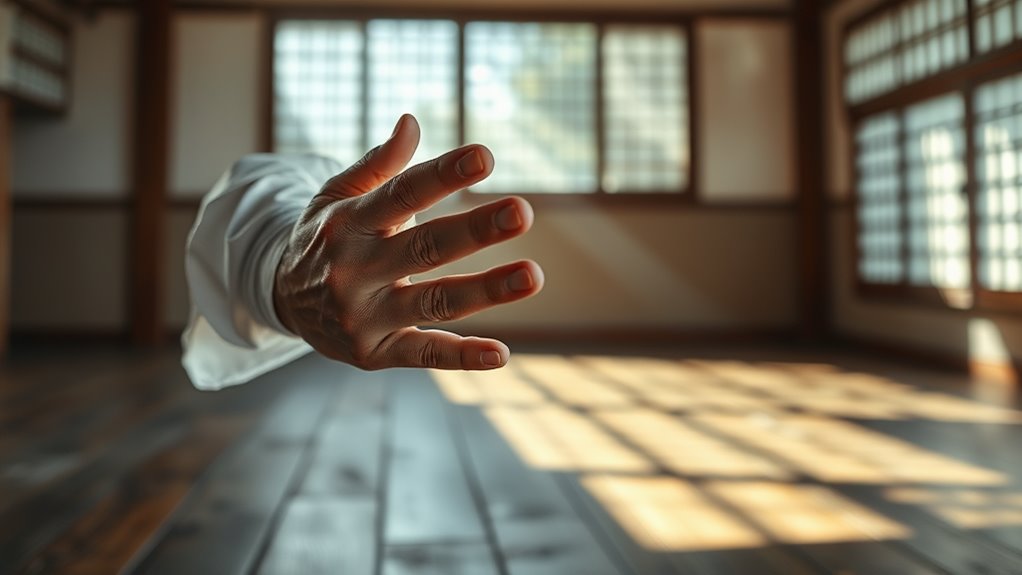
Gentle martial arts movements can help manage arthritis symptoms while building strength and flexibility.
You'll find that modified martial practices like tai chi and qigong emphasize controlled, low-impact movements that protect your joints while improving their function. These arts teach you to move with awareness and precision, helping to reduce inflammation and stiffness.
By practicing specific joint mobility exercises from martial traditions, you can maintain and even expand your range of motion.
Focus on fluid circular movements and gentle stretches that respect your current limitations. You'll learn to recognize early warning signs of overexertion and adjust accordingly. Progressive training also strengthens the muscles around affected joints, providing better support and stability.
Many traditional martial arts incorporate meditation and breathing techniques that help manage pain perception and reduce stress – factors that often worsen arthritis symptoms.
You're empowered to take an active role in your arthritis management through these time-tested movement practices.
Traditional Weapons Training Benefits
Traditional weapons training offers unique advantages for developing coordination and full-body strength as you age. As you practice traditional weaponry techniques, you'll discover how ancient martial artists integrated cultural heritage influence into movements that challenge both mind and body. Your training with weapons like the staff, sword, or nunchaku will enhance your physical capabilities while connecting you to centuries of martial wisdom.
- You'll develop superior hand-eye coordination and spatial awareness through precise weapon manipulation.
- Your core strength and balance will improve as you master complex movement patterns.
- Traditional weapons practice engages your entire kinetic chain, promoting better mobility and posture.
This specialized training transcends basic exercise by incorporating mindfulness and focused breathing. When you're wielding traditional weapons, you're not just building strength – you're participating in a time-tested system that promotes neuroplasticity and maintains cognitive function.
Each practice session becomes an opportunity to refine your movements while honoring martial traditions.
Breathing for Blood Pressure Control
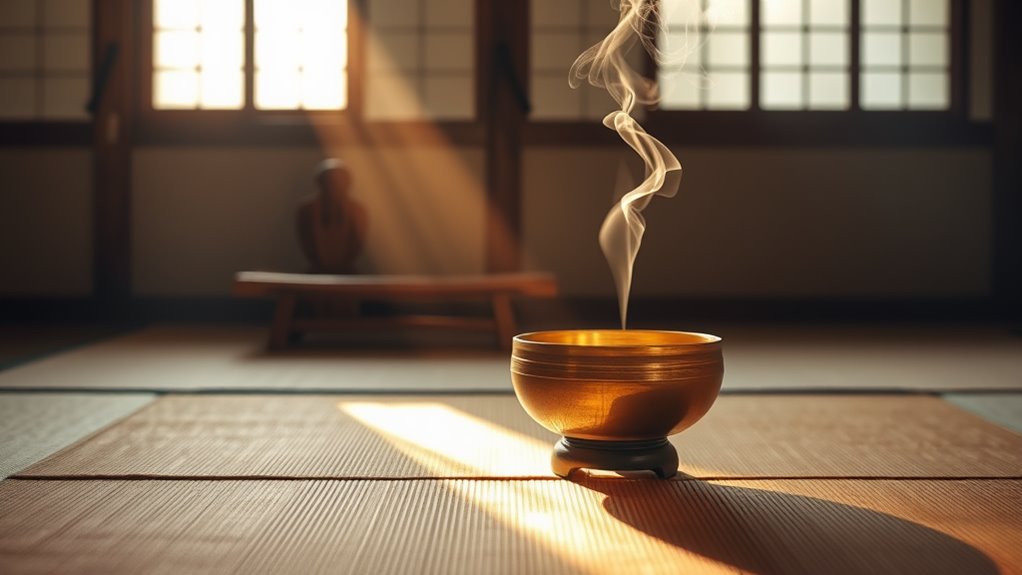
Through deliberate breathing techniques found in martial arts, you can effectively manage your blood pressure and cardiovascular health. Learning breath control creates a powerful impact on hypertension management, as you'll discover through consistent practice.
| Breathing Type | Blood Pressure Effect | Practice Duration |
|---|---|---|
| Deep Diaphragmatic | Reduces Systolic | 5-10 minutes |
| Box Breathing | Stabilizes Both | 3-5 minutes |
| Lion's Breath | Lowers Diastolic | 2-3 minutes |
| Counted Exhale | Reduces Overall | 5-7 minutes |
You'll find that these martial arts breathing methods work by activating your parasympathetic nervous system. By extending your exhales longer than your inhales, you're triggering your body's natural relaxation response. Start with just five minutes daily, focusing on smooth, controlled breaths. As you progress, you'll notice improved blood pressure readings and a greater sense of calm during your training sessions.
Building Community in Senior Training
While training in martial arts offers numerous physical benefits, the social connections formed in senior-focused classes create equally important advantages for healthy aging.
You'll discover that community engagement becomes a natural part of your martial arts journey, fostering meaningful relationships with fellow practitioners who share your commitment to wellness and personal growth.
- Regular group training sessions build lasting friendships and support networks that extend beyond the dojo.
- Shared challenges and achievements create strong bonds through group dynamics and mutual encouragement.
- Structured partner exercises promote trust, communication, and social interaction.
The collaborative nature of senior martial arts training helps combat isolation, which research shows can negatively impact both mental and physical health.
Senior martial arts training creates vital social bonds, helping older adults stay connected and healthy in both mind and body.
You'll find yourself part of a vibrant community where everyone supports each other's progress.
This social dimension transforms your martial arts practice into more than just exercise – it becomes a fulfilling lifestyle that nurtures both body and spirit through meaningful human connections.
Martial Arts and Pain Prevention

Regular martial arts training offers powerful tools for preventing chronic pain and physical discomfort as you age. Through mindful movement and proper technique, you'll learn essential pain management strategies while building protective strength around vulnerable joints.
The deliberate practice of martial arts forms helps you develop body awareness and correct alignment, reducing your risk of injury.
You'll discover how to move efficiently by engaging your core and maintaining proper posture, which prevents unnecessary strain on your spine and joints. The controlled movements in martial arts teach you joint protection principles that you can apply to daily activities. From lifting groceries to climbing stairs, these skills translate directly to pain-free living.
Most importantly, you'll gain confidence in your body's capabilities while learning to distinguish between beneficial training discomfort and harmful pain signals. This body wisdom becomes invaluable for maintaining mobility and independence throughout your life.
Maintaining Independence Through Training
Training in martial arts equips you with essential physical and mental skills that support long-term independence. Through intentional practice and self-discipline, you'll develop adaptability skills that serve you well into your later years.
Martial arts training builds lifelong independence through physical mastery and mental discipline, creating adaptable skills that endure as we age.
The combination of physical training and mental conditioning creates a foundation for personal growth and emotional resilience.
- You'll build confidence through progressive achievement, mastering self-defense basics while setting and reaching new goals.
- Regular training provides natural stress relief and helps maintain your physical capabilities, which directly impacts your ability to live independently.
- The community support in martial arts studios creates lasting connections that contribute to both your social well-being and safety network.
The journey isn't just about learning techniques – it's about developing a mindset of continuous improvement.
Sleep Quality and Martial Practice
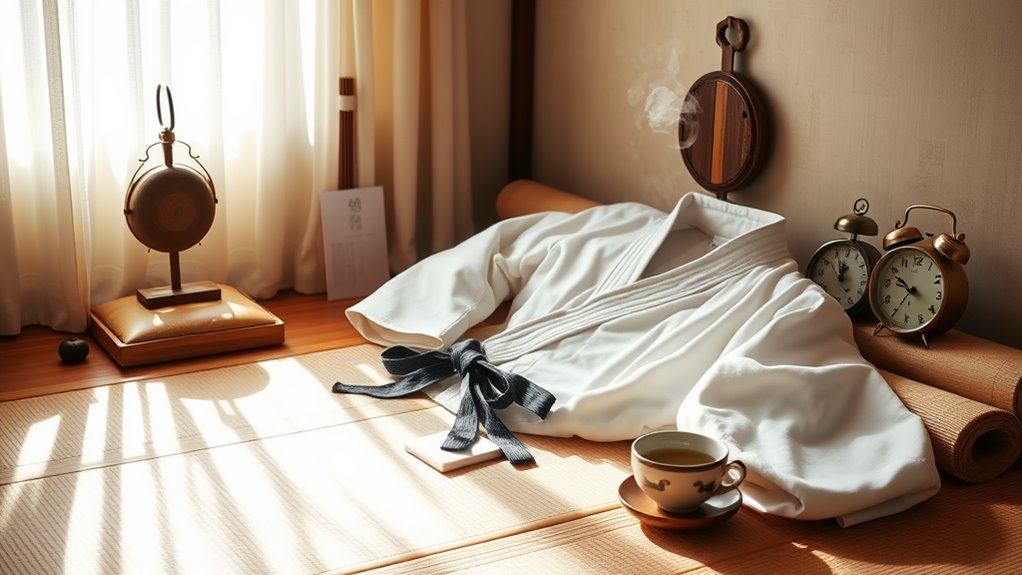
Practicing martial arts can greatly enhance your sleep quality through its unique combination of physical exertion and mental discipline.
You'll discover that regular training naturally aligns your sleep patterns with your body's ideal rhythms, reducing common sleep disturbances and improving sleep cycles. The mindfulness techniques you learn on the mat translate directly into effective sleep rituals that calm your mind before bedtime.
Your sleep benefits multiply as you advance in your practice, with heightened sleep engagement leading to better recovery between training sessions.
You'll develop personalized sleep strategies that complement your martial journey, incorporating breathing exercises and meditation. These sleep enhancement methods work synergistically with your training, creating a powerful feedback loop of improved performance and rest.
The sleep importance becomes evident as you notice sharper reflexes, better focus, and increased energy.
Your sleep mindfulness practice becomes an extension of your martial arts training, supporting both your physical and mental development.
Creating Sustainable Training Habits
While many enthusiasts start martial arts with intense passion, building sustainable training habits requires a methodical approach that balances enthusiasm with realistic goals.
You'll find that sustainable routines emerge when you align your training with your lifestyle, energy levels, and personal commitments.
- Start with 2-3 weekly sessions, allowing proper recovery time and preventing burnout.
- Track your progress using a training journal to identify patterns and make adjustments.
- Combine martial arts with complementary activities like mobility work or meditation.
Habit formation happens gradually, so you'll want to focus on consistency rather than intensity.
Build your practice around times when you're most energetic and likely to follow through. If you're a morning person, train early; if you peak in the evening, schedule accordingly.
Remember that sustainable routines aren't about perfection – they're about creating a practice that serves you for years to come.
FAQs
Can Martial Arts Training Help Reverse Existing Age-Related Memory Loss?
You can't fully reverse age-related memory loss, but you can slow its progression and boost your cognitive function through strategic movement.
Research shows martial arts training delivers powerful memory enhancement benefits through pattern recognition, sequenced movements, and mind-body coordination.
You'll strengthen neural pathways, improve focus, and build cognitive resilience while mastering techniques that challenge both your body and brain in dynamic ways.
What Insurance Considerations Should Seniors Have Before Starting Martial Arts?
Before starting any physical activity program, you'll want to review your insurance coverage carefully.
Check if your policy covers sports-related injuries and what deductibles apply. Consider supplemental coverage if needed.
For injury prevention, get a medical clearance from your doctor and verify the instructor's credentials and facility insurance.
Don't forget to ask about specific accommodations for seniors and emergency protocols at your chosen training location.
How Do Medications Affect Martial Arts Performance in Older Practitioners?
Like a medieval alchemist monitoring their elixirs, you'll need to carefully track your medication interactions.
Blood thinners can increase bruising risk, while beta-blockers might affect your stamina.
You'll notice performance limitations with certain pain medications or antihistamines that cause drowsiness.
Talk to your doctor about timing your meds around training, and don't be afraid to adjust your practice intensity based on your medication schedule.
Are There Martial Arts Styles Specifically Created for Elderly Beginners?
You'll find several martial arts styles specifically developed for older beginners, including Chair Tai Chi, Senior Karate, and Modified Qigong.
These incorporate gentle techniques that work with your natural range of motion rather than forcing extreme movements.
Many dojos now offer adaptive exercises tailored to mature students, letting you build strength and balance at your own pace.
You can start with simplified forms and gradually progress as your confidence grows.
Can Martial Arts Training Interfere With Existing Medical Treatments?
Your health journey can be transformed through martial arts, but you'll need to be mindful of potential interactions with medical conditions.
It's essential to consult your healthcare provider before starting, as certain movements might affect your treatment plan.
Don't worry though – most martial arts schools can offer training modifications and work with your rehabilitation strategies to create a safe, effective practice that complements your medical care.
In Summary
You're never too old to step onto the mat and reap the rewards of martial arts training. Research shows practitioners over 50 who train consistently are hitting the nail on the head when it comes to healthy aging. With improved balance, strength, and cognitive function, you'll maintain independence longer while building a resilient mind-body connection. Start where you are, adapt as needed, and embrace this time-tested path to longevity.


